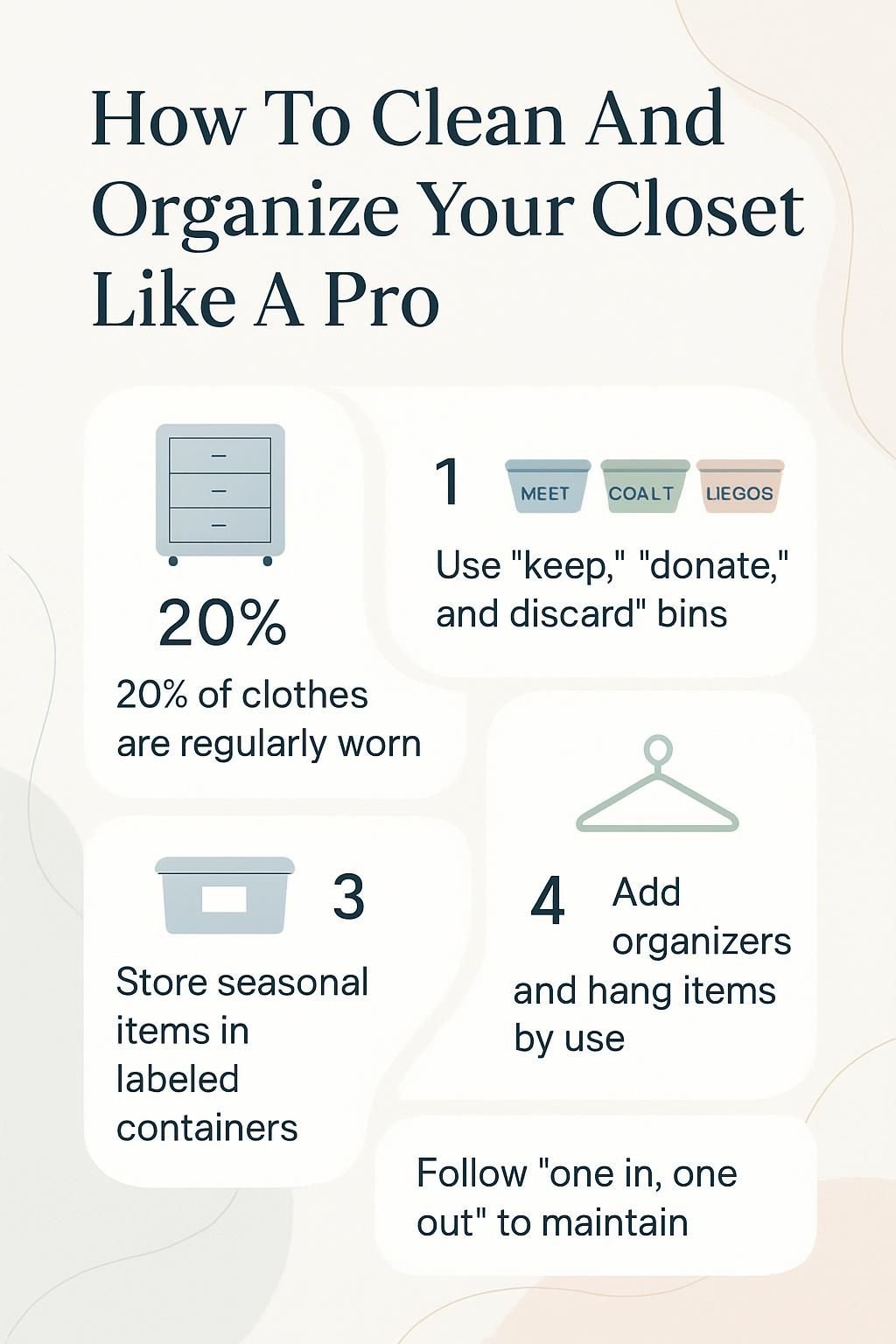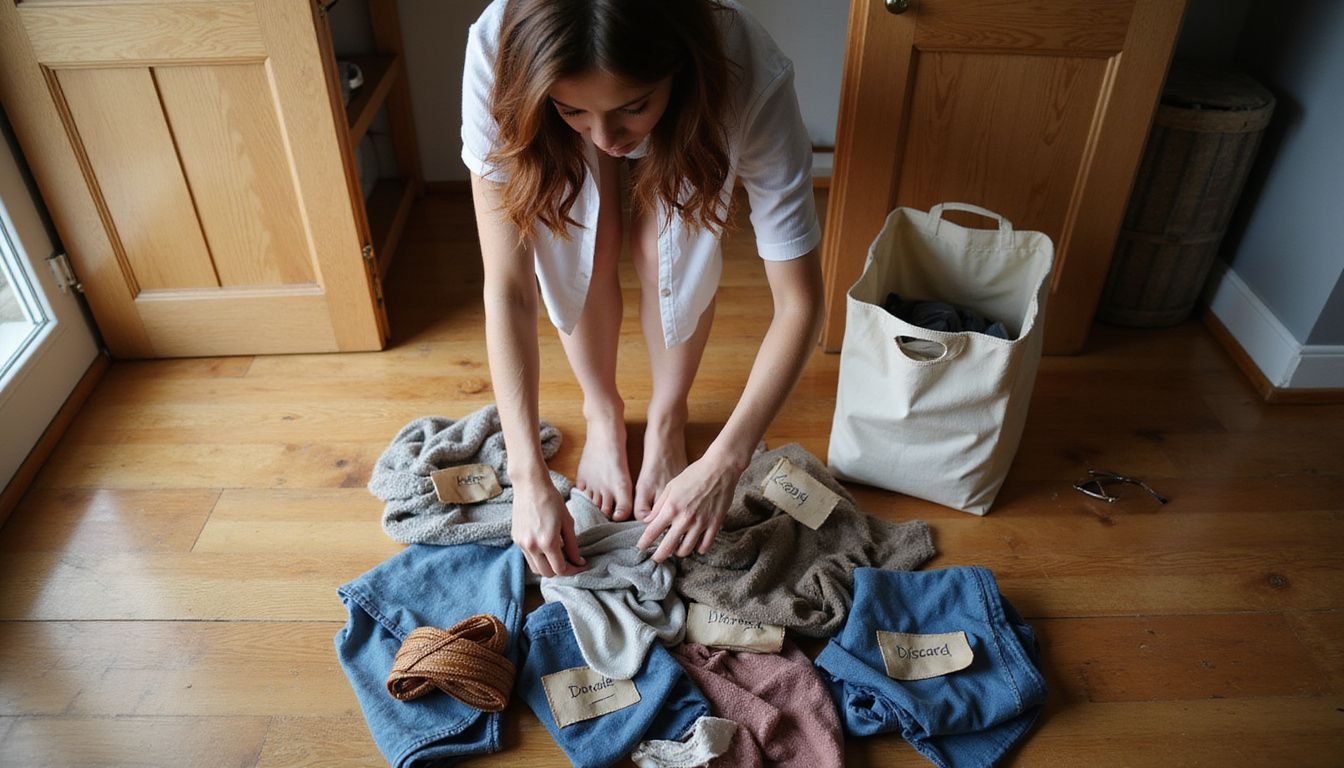Messy closets often cause stress in busy homes. Many people struggle to find their favorite shirt, shoes, or that extra pair of jeans under piles of clothes and clutter. Overflowing hangers and crowded shelves waste time every morning.
Studies show that most people wear only 20% of what is in their closet. This means a huge chunk of space goes unused or gets filled with items never worn. Expert closet organization can save both time and money.
This guide will break down each step for “How To Clean And Organize Your Closet Like A Pro.” Readers will learn simple ways to sort, clean, and arrange clothing using proven tips from professional organizers.
Get ready for a fresh start that makes mornings easier than ever. Discover smarter ways to tackle your mess today!

Empty Your Closet Completely

Initiating the process of closet organization involves a crucial step of emptying your closet in its entirety. This action paves the way for a successful and effective decluttering and reorganization process.
- Initiate by evacuating every piece of clothing, footwear, and accessories from the closet. This reveals unseen items and provides an unobstructed view of the space at hand.
- Arrange everything on a spacious, neat surface. Utilizing a bed or a pristine floor would be appropriate for this action.
- Utilize this opportunity to examine each piece for signs of wear and tear. Observe the seams, fabric strength, and the general state of the item.
- Assign separate bins or sections for different categories like ‘keep,’ ‘donate,’ and ‘discard.’ This eases the decision-making process.
- Assess seasonal attire with a critical perspective. Determine whether to continue its cycle or put it away for storage.
- Review items that have stayed unworn for over a year. It is likely these could be contributed.
- In the case of families, include household members in sorting their own possessions. This promotes collective participation in the decluttering process.
- Inspect pockets, handbags, and secret compartments for overlooked items before finalizing decisions on each article.
- Think about reserving distinctive or costly items that could potentially be sold rather than donated or discarded.
- Lastly, compile a list of what stays to guarantee you retain only what you truly utilize or cherish.
By following these steps, an effective closet organization process is facilitated, offering a clear understanding of what belongings are genuinely worth retaining and which ones can be excluded to significantly simplify wardrobe management and upkeep efforts.https://www.youtube.com/watch?v=a-TFbunklsQ
Sort Your Items into Categories
Clearing out the closet entirely, homeowners and parents can then categorize their items into sections like keep, donate, and discard, streamlining the decluttering process. Rotating seasonal clothing guarantees a well-ordered space that accommodates the demands of a constantly evolving wardrobe.
Keep, Donate, and Discard
Decluttering a closet involves making tough decisions about what stays and what goes. House owners and parents face the challenge of sorting through items to create a minimalist wardrobe that reflects their current lifestyle and preferences.
- Keep: Choose items that fit well, get regular use, and bring joy. Anything that is part of a capsule wardrobe or serves multiple purposes should stay. This includes clothing that matches personal style, favorite pieces, or those necessary for work and special occasions.
- Donate: Clothing in good condition but no longer worn deserves a second life with someone else. Consider donating to local shelters, charity shops, or community centers. Items perfect for donation include out-of-style clothes still in good shape, gently used children’s clothing that they have outgrown, and duplicate items where only one is used.
- Discard: Discard clothing that is beyond repair, stained, or damaged. This includes socks with holes, underwear past its prime, and anything else not suitable for donation or selling. Responsibly disposing of these items helps keep the closet free from clutter.
After sorting the closet into these categories, transitioning seasonal clothing becomes easier.
Transition Seasonal Clothing
Transitioning seasonal clothing is a crucial element of closet organization. It assists homeowners and parents in maintaining a practical and orderly wardrobe throughout the year.
- Spot clothing that is no longer appropriate for the current season. Scan your wardrobe to locate items you won’t be using in the upcoming months.
- Clean the selected clothes prior to storage. This action helps to ward off musty smells and maintain the condition of the clothes.
- Opt for suitable storage methods. Consider vacuum-sealed bags or bins for voluminous items such as winter coats to conserve space.
- Clearly mark storage containers. Designate them with identifiers like the season, year, or type of clothing for simple identification later on.
- Keep non-seasonal items in a space that is cool and dry. Try to skip locations with a tendency for dampness like basements or attics if feasible.
- Rotate fundamental items according to forthcoming weather patterns. Keep a selection of versatile pieces at hand for unexpected weather shifts.
This strategy helps keep your space orderly and also simplifies the process of assembling outfits speedily.
Subsequently, acquire knowledge on how to efficiently cleanse your closet space for a refreshing beginning.
Clean Your Closet Space
Remove all items from the closet. Dust shelves, wipe down surfaces; consider repainting or installing new lighting to refresh the space. Vacuum or sweep the floor thoroughly before placing items back in.
Use a microfiber cloth and mild cleaner to dust off any accessories or decorations.
Consider implementing vacuum-sealed bags for seasonal clothes that aren’t currently being used to save space and protect your clothing from damage. Utilize storage solutions such as baskets, hooks, and bins to keep things organized while making it easier to find what you’re looking for amidst the chaos of everyday life.
Maximize Your Closet Storage
Optimize your closet storage by using organizers and dividers to make the most of the space, strategically hanging clothes for easy access, and arranging items based on accessibility. Find out more for expert advice on maximizing your closet space!
Use Organizers and Dividers
Maximize closet space by utilizing organizers and dividers. Implementing these tools can significantly improve the functionality of your wardrobe. By using shelf dividers, one can neatly separate stacks of sweaters or handbags, preventing them from toppling over and creating a cluttered mess.
Moreover, drawer organizers are perfect for keeping socks, undergarments, and accessories tidy and easily accessible. Hanging organizers can also optimize vertical space in the closet while ensuring that items such as shoes or scarves remain organized and visible, making it easier to grab what you need when rushing out the door.
Now let’s explore strategically hanging clothes to maximize space efficiently in your closet.
Hang Clothes Strategically
To enhance the functionality of a closet, strategic organization of clothes can make a significant difference. By arranging items based on their frequency of use, individuals can optimize space and improve accessibility.
This involves placing frequently worn garments at eye level while reserving higher or lower sections for less-used items. Moreover, grouping similar clothing types together not just streamlines the process of selecting outfits but also maximizes available storage.
In addition, using slim-line hangers conserves space and creates a uniform appearance within the closet. Homeowners and parents should consider integrating these strategies to effectively manage their wardrobe while enhancing overall organization and decluttering endeavors.
Arrange Items by Accessibility
House owners and parents can make their closets more efficient by arranging items based on accessibility. This makes it easier to find what you need and maintain an organized space, especially when juggling household responsibilities.
- Place frequently used items at eye level or within easy reach.
- Store seasonal or less frequently used items on higher shelves or in less accessible areas.
- Utilize storage bins or baskets for smaller items like accessories and undergarments.
- Group similar items together to streamline the search process, for example, keeping all shirts together and pants in another area.
- Consider adding hooks or racks to the closet door for commonly worn outerwear or bags.
- Implement a rotating system for children’s clothing, ensuring that their most worn items are readily available.
Maintain Your Organized Closet
To maintain an organized closet, regularly assess clothes to remove any items that are no longer worn or needed. House owners and parents can make this a seasonal habit to keep the wardrobe clutter-free.
Implement a rule of “one in, one out” to avoid accumulating excess clothing. Utilize organizers and dividers for efficient storage solutions, ensuring all items have designated spaces within the closet.
By following these practices, individuals can ensure their closets stay neat and functional throughout the year.
In addition, rotating seasonal clothing with each change in weather helps maximize storage space. As summer turns to fall or winter transitions into spring, consider swapping out clothing to accommodate the current season’s needs while keeping the closet well-organized at all times.
These simple yet effective strategies contribute significantly to maintaining an orderly closet for house owners and parents alike.
Conclusion
In conclusion, cleaning and organizing a closet like a pro requires dedication and proper planning. Emptying the closet completely is vital for sorting items efficiently. Utilizing organizers and dividers can maximize storage space effectively.
Arranging items by accessibility ensures easy retrieval of clothing. Maintaining an organized closet regularly is essential for sustaining the achieved organization. Applying these actionable steps will result in a well-organized closet that allows easy access to desired items whenever needed.
FAQs
1. What are the first steps to clean my closet?
Start by emptying your closet completely. Remove all items and sort them into categories like keep, donate, or discard. This helps you see what you have.
2. How can I organize my closet effectively?
Use storage bins and hangers wisely. Group similar items together, such as shirts with shirts and shoes with shoes. Label boxes for easy access to everything.
3. What common mistakes should I avoid while organizing?
Avoid keeping clothes that no longer fit or that you haven’t worn in a year. Do not overcrowd your space; this makes it harder to find what you need.
4. How often should I clean and organize my closet?
Aim to clean your closet at least twice a year. Regularly check for items you no longer use, keeping your space organized and functional over time.


